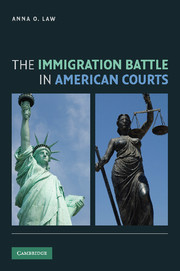Book contents
- Frontmatter
- Contents
- List of Tables and Figures
- Acknowledgments
- 1 Introduction
- 2 How Do We Know What We Know? Data, Methods, and Initial Findings
- 3 The Rise of Two Courts with Differentiated Functions
- 4 Interstitial Policy Making in the U.S. Courts of Appeals
- 5 Institutional Growth and Innovation: The Ninth Circuit Court of Appeals and Immigration
- 6 Continuity Amid Change: The Federal Courts' Commitment to Due Process
- 7 Conclusion
- Appendix A Further Elaboration of Case Selection Methods
- Appendix B Further Elaboration on the Search for Modes of Legal Reasoning
- Appendix C Numerical Codes for Modes of Legal Reasoning
- Appendix D Interview Questions
- Index
Appendix A - Further Elaboration of Case Selection Methods
Published online by Cambridge University Press: 04 August 2010
- Frontmatter
- Contents
- List of Tables and Figures
- Acknowledgments
- 1 Introduction
- 2 How Do We Know What We Know? Data, Methods, and Initial Findings
- 3 The Rise of Two Courts with Differentiated Functions
- 4 Interstitial Policy Making in the U.S. Courts of Appeals
- 5 Institutional Growth and Innovation: The Ninth Circuit Court of Appeals and Immigration
- 6 Continuity Amid Change: The Federal Courts' Commitment to Due Process
- 7 Conclusion
- Appendix A Further Elaboration of Case Selection Methods
- Appendix B Further Elaboration on the Search for Modes of Legal Reasoning
- Appendix C Numerical Codes for Modes of Legal Reasoning
- Appendix D Interview Questions
- Index
Summary
CASE SELECTION
The cases in this original database were generated through a Lexis/Nexis search using the keywords “immigration” and “exclusion” or “deportation” with the relevant time constraints. These search terms generated two lists of cases, one of U.S. Supreme Court cases and the other of cases from circuit courts and from the U.S. Courts of Appeals. Any cases that were not actually immigration, exclusion, or deportation cases were not included in the sample. (These search terms occasionally picked up real estate or criminal cases having only tangential relevance to immigration.)
The immigration cases included in this study are either exclusion or deportation cases. I limited the study to these two types of immigration cases to maintain analytical consistency in the types of constitutional, other legal and political issues that arise in these cases. In an exclusion case, a court must decide if a person may enter U.S. territory; in a deportation case, a court must decide if a person may remain in the United States. Immigration scholars regard these types of entry/exit decisions as immigration policy. Exclusion and deportation cases also constitute the most common types of immigration cases and limiting the sample to these cases captures the majority of all immigration cases, including alienage and naturalization cases, in which the courts must decide whom to admit, symbolically, to the polity. I did not limit my search to plenary power cases, which would have skewed the sample.
- Type
- Chapter
- Information
- The Immigration Battle in American Courts , pp. 237 - 240Publisher: Cambridge University PressPrint publication year: 2010

